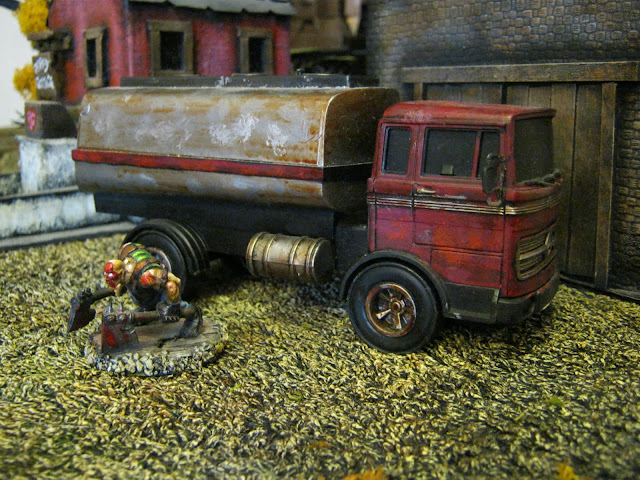Cars are very hard to buy at the right scale for 28mm miniature gaming and certain alleged scales can't be relied upon to match from one vehicle to the next. Basically, to the manufacturers, it's all about fitting the box they want to sell the item in so be careful.
Anyway, here are some fairly sturdy rules I've play tested quite a few times that seem complicated at first but aren't too bad once you get your head round them. They have a fairly realistic feel to them.
Hotwiring
For every 2 actions spent, roll 3d10. 3 successes (6+) must be rolled to start the vehicle.
Movement
The driver of a vehicle must spend one action driving each turn.
A car goes YELLOW in the turn it starts driving(8"). It can drive any speed up to RED (24").
The car needn't go the entire distance but must still be set at a particular speed.
When going RED the car can ONLY go straight ahead. When attempting turns when going WHITE (18") the car must Roll for Control. The control roll is made half way through the turn
If a car wants to stop it can do so at the end of its move. A car must go a minimum of BLUE (6") distance in the turn it stops if it is stopping unexpectedly.
Cars cannot turn on the spot. The car model must be turned realistically as it drives forward.
Getting In and Out of Cars
It takes one action to get in or out of a stationery car and one action to start her up.
Losing Control
Roll for Control by rolling 2 Lethal Dice.
If any Hits are scored then control is maintained.
If control is lost the car will go in a random direction (in the front 90 degree arc) the next time it moves (Roll 1d6: 1-2 left 45 degrees, 3-4 straight on, 5-6 right 45 degrees).
It will continue at the same speed it went before going Out of Control.
If it is half way through a move when control is lost then it goes straight in the random direction.
If it hits anything substantial it will crash and stop. A crashed car is wrecked for the rest of the game.
If the car doesn't crash then a 2 Dice Roll for Control must be made after its move to regain control
Ramming
Ramming cars do damage to whatever they hit determined by their relative speed
See damage chart
Any Hits rolled against targets count toward damaging the car itself
If the car stops as a result of a ram then it continues to move at least BLUE first unless it is the result of a head-on collision
Subtract one speed from the next if one car is ramming another and they are both going in the same direction
Total the speeds if they ram head-on
The speed of creatures rammed is not taken into account
Damage from Rams & Crashes
Damage to Targets Hit | Crash Damage to Occupants | ||||
Speed | Lethal Dice | Bash Dice | Lethal Dice | ||
Blue | 3 | 1 | |||
Yellow | 4 | 2 | |||
Green | 6 | 3 | 1 | ||
White | 6 | 3 | 2 | ||
Red | 8 | 3 | 3 | ||
Attacking Cars
Cars are unaffected by Pushbacks.
Attacks that cause damage are defined as Hits on the table below.
Obviously close combat attacks against the front of a car are going to result in a ram on the driver's turn.
Passengers inside the car can be attacked. If the car is moving there are -2 Dice to attacks. Stationery cars impose -1 Dice to attacks.
Damage to Car and Occupants | |||
No. of Hits | Effect | ||
2 | Roll for Control on | 2 Dice | |
3 | Roll for Control on | 1 Die | |
4 | Out of Control | ||
5+ | Out of Control | Car will not drive again | |
Jumping On and Off Moving Vehicles
Characters can jump onto a moving car if the difference between the speed they are travelling (zero for pedestrians) is no more than one speed bracket away.
For example, a pedestrian can jump onto a car going up to BLUE. A character riding a car going GREEN could jump onto one going WHITE.
Characters take 2 Bash Dice when doing so and have to roll at least one success (6+) on 2d10 to manage it successfully.



The background image on your blog makes the white text nearly impossible to read. It was highly reccommended to me, but it's visually painful to look at for long. Even the grey partial mask doesn't help much.
ReplyDelete